Published on April 14, 2023 by Prashant Juneja
Introduction
Climate change and global warming are threats to society and can have detrimental effects on future generations. To combat climate change, it is essential to understand its cause – global warming. Global warming is a natural phenomenon and refers to “greenhouse gases” that trap heat close to the Earth’s surface like a blanket. To reduce global warming, therefore, we need to reduce emitting greenhouse gases (GHGs) such as carbon dioxide, methane, nitrous oxide, hydrochlorofluorocarbons, hydrofluorocarbons and ozone.
Decarbonisation refers to reducing and ultimately removing carbon emissions, which can be achieved by using low-carbon energy sources.
The Paris Agreement 2015, the legally binding treaty on climate change, aims to limit global warming to well below 2° Celsius, preferably to 1.5° Celsius, compared to pre-industrial levels. Global temperature can be controlled only through reducing GHG emissions.
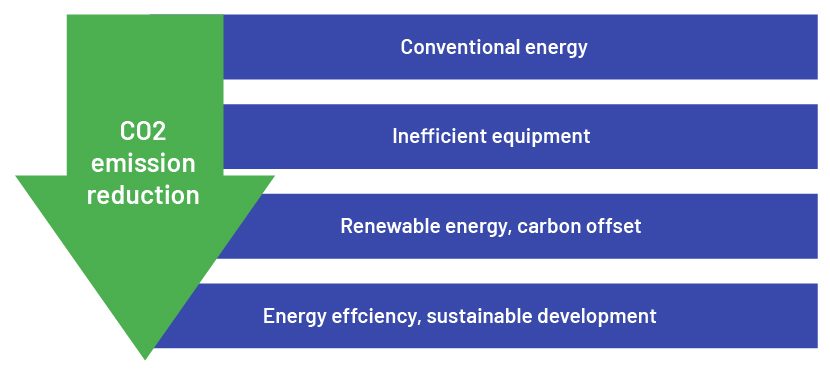
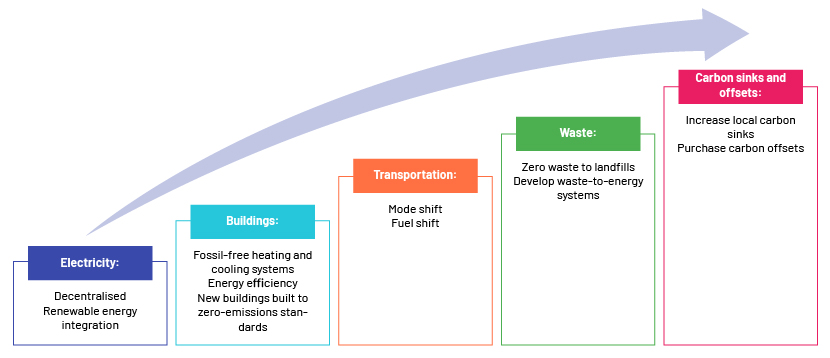
The path to decarbonising emission-prone sectors
To reduce GHGs emissions, we first need to understand the major contributors.
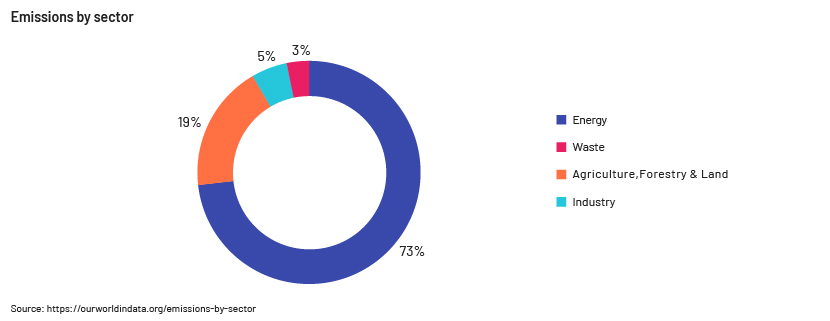
Energy sector:
It is evident that the energy sector accounts for most of the carbon emissions. Contribution by segment is detailed below:
-
Energy use in industry: 24%
-
Energy use in transport: 16.2%
-
Energy use in buildings: 17.5%
1. Emissions from the industry segment and the path to decarbonisation:
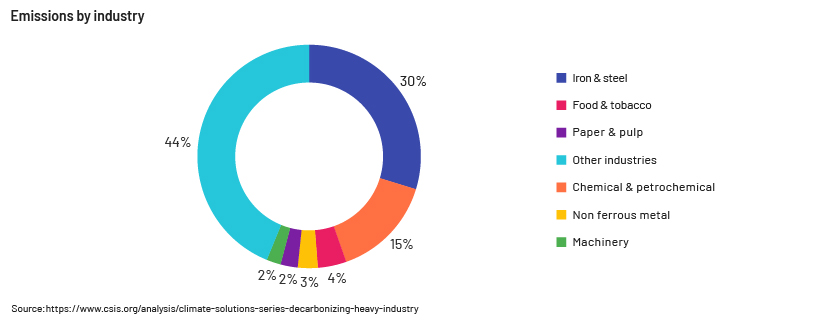
The industry segment of the energy sector would need to reduce 80-90% of its emissions. Decarbonisation studies have found that ammonia, cement, ethylene and steel companies can reduce their carbon emissions to almost zero through improvements in energy efficiency, electric production of heat, use of hydrogen and biomass as feedstock or fuel, and carbon sequestration.
Almost 45% of industrial carbon dioxide emissions come from the production of cement, steel, ammonia and ethylene, but it is difficult to reduce these emissions for the following reasons:
-
Only by changing processes and the use of fuel can carbon dioxide emissions from feedstock be reduced
-
Fossil fuels are required to generate very high temperatures. Switching from fossil fuels to alternative fuels would require significant changes in furnace design
-
Changes in one part of a process would require changes in another part of the process; this takes time and would impact production
-
Changing processes would require costly rebuilds or retrofits
Industrial companies could reduce carbon emissions by combining decarbonisation technologies such as demand-side measures, energy-efficient equipment, electrification of heat, using hydrogen and biomass as feedstock, and fuel and carbon sequestration techniques.

2. Emissions from the transport segment and the path to decarbonisation: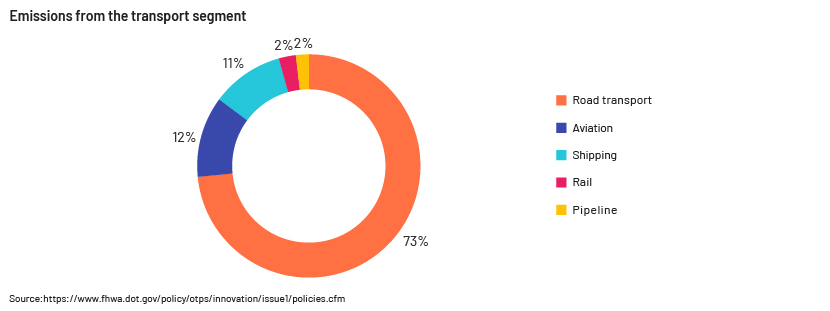
Policymakers are taking the decarbonisation of the transport segment seriously, as global GHG emissions from the segment are forecast to increase to 50-60% of total emissions by 2050. The segment relies heavily on fossil fuels to generate energy; renewable energy accounts for only around 3.7% of energy generated.
The avoid-shift-improve approach to environmental sustainability requires a transition to clean-energy fuels an improving vehicle efficient if the transport segment is to move towards decarbonisation.

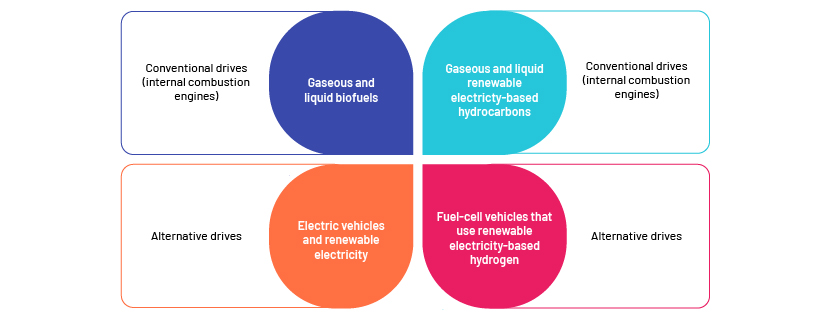


The building segment currently accounts for about one-third of global energy consumption; this is likely to increase significantly in the coming years, requiring that it adopt strategies such as the following to mitigate GHG emissions.
-
Adopting a green buildings rating system
-
Using energy-efficient equipment and at least 3-star rated appliances
-
Deploying decentralised renewable-energy systems
-
Installing a building management system and smart meters
-
Developing buildings with low rankings on the Energy Performance Index

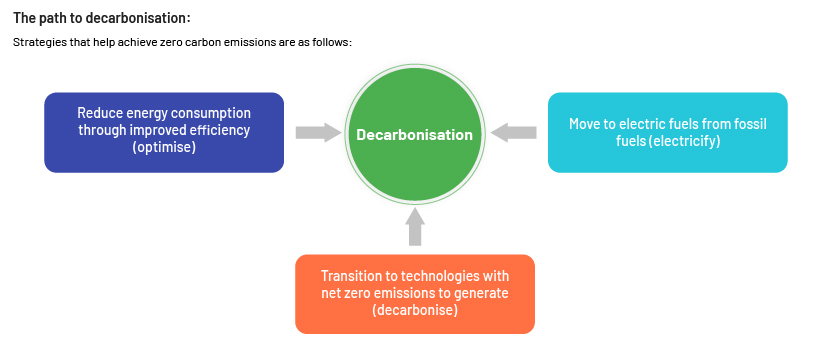
Factors contributing to decarbonisation:
-
Financing energy-efficient sectors
-
Hydropower installations
-
Financing the non-hydro renewables segment
-
Electrification of the energy sector
-
Electrification of the building segment, although the transport segment lags behind
-
Adherence to clean, energy-efficient and decarbonisation methods
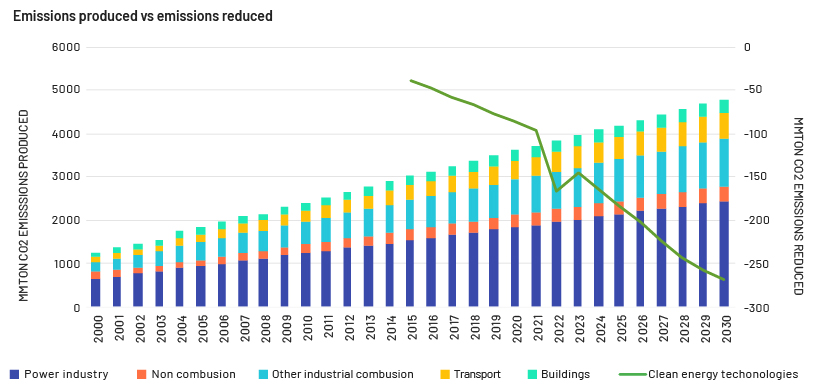
Digital transformation – key to decarbonisation
Digitalisation would help to deliver electricity in a safer and more reliable way to customers. This would involve application of artificial intelligence (AI), blockchain and the internet of things (IoT) to make solutions more reliable, efficient, and user-friendly.

Leaders in decarbonisation:-
Tata Group:
The group has embraced the challenge of combating climate change and has established Tata Sustainability Group to do so. It integrates issues relating to climate change with business strategy in three ways: mitigation, adaptation and responsible advocacy. Key companies are encouraged to reduce carbon emissions and move to low-carbon operations, in line with the objectives of the Paris Agreement and science-based targets. The transition to low-carbon operations has been accelerated by the adoption of internal carbon pricing the group: Tata Steel, Tata Chemicals, Tata Motors and Tata Global Beverages.
Tata companies strive to deal with the complex phenomenon of climate change through collaboration with organisations such as the World Business Council for Sustainable Development, the Task Force on Climate-Related Financial Disclosures, the World Bank’s Carbon Pricing Leadership Coalition, the World Economic Forum’s Alliance of CEO Climate Leaders and the Energy Transitions Commission.
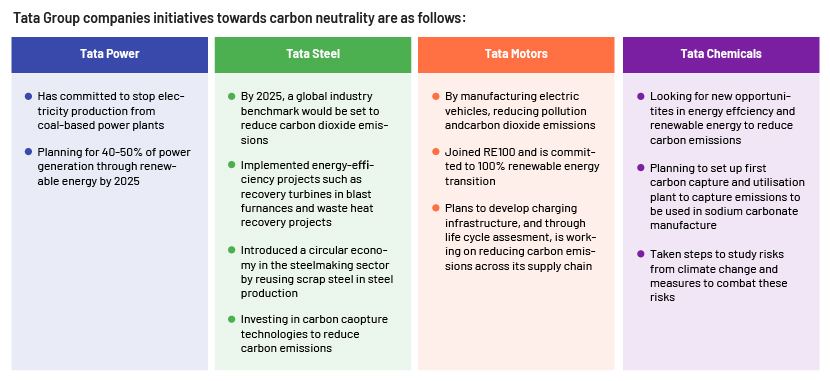
Reliance Group:
Reliance has pledged to become net carbon zero by 2035. It is adopting new green technologies and plans to develop carbon capture and storage technology that will use carbon dioxide as a useful feedstock rather than as a waste product. It will convert transportation fuels into clean electricity and hydrogen.
The net zero carbon target is driven by sustainable development and cleaner technologies through three strategic key focus areas: digital technology platforms, new ecommerce (connecting Kirana stores through Jio Mart platforms) and decarbonisation, which would lead to greater financial participation and economic involvement of Indian citizens.
Sustainable development – steps towards net zero:
Sustainability refers to using resources efficiently. The environmental impact of operations can be reduced in three ways:
-
Reducing dependence on freshwater by reusing water through water management and wastewater recycling systems
-
Encouraging waste management practices by reducing waste disposal and increasing waste recycling
-
Reducing emissions from operations and the supply chain
The company envisions transitioning to net zero by shifting strategy from B2B to D2C that is generating value for the end consumer. This requires substantial investment in research, development, innovation and training.
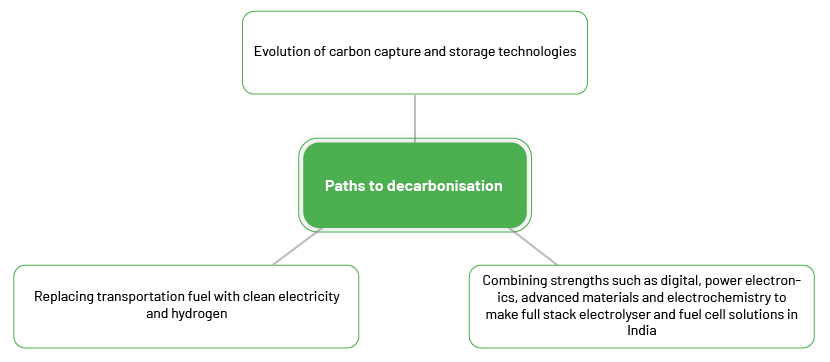
Climate strategy to achieve net zero carbon emissions requires substantial investment in the following areas:
-
Solar panel and energy storage battery manufacturing
-
Hydrogen production and fuel-cell factory to convert hydrogen to power, with hydrogen having applications in transportation and power generation
-
Providing an ecosystem for infrastructure and materials to support constructing iga factories
-
Supporting self-reliant manufacturers within the ecosystem
-
Investing in the supply chain including in upstream and downstream industries
How Acuity Knowledge Partners can help
We have a pool of experiential experts across the power and energy sectors. Those experts can provide support in developing strategies for decarbonization and marking the way towards net-zero targets. We also assist our clients’ teams with market assessments of cleaner energy technologies and make use of business intelligence to highlight the gaps in technologies that will mark the way towards decarbonization. We have dedicated sustainability experts’ teams who can help the clients with research analytics, business development, and strategy building for carbon neutral technologies that accelerate the path towards decarbonization.
Sources:-
-
https://www.ibm.com/blogs/internet-of-things/sustainably-accelerating-decarbonization/
-
https://www.worldometers.info/co2-emissions/india-co2-emissions/#google_vignette
-
https://www.mckinsey.com/~/media/mckinsey/business%20functions/sustainability/
-
https://www.brookings.edu/research/the-challenge-of-decarbonizing-heavy-industry/
Tags:
What's your view?
About the Author
Prashant is working as Delivery Lead for Energy & utilities domain in Acuity Knowledge Partners Private Equity and Consulting vertical. He has over 6 years of experience in energy and sustainability sector helping the clients across various domains by providing solutions for Energy efficiency, Green building ratings system, Water efficiency and Renewable energy. He has also been part of research on trending technologies like ESG, impact investment, socially responsible investment, Decarbonization trends in various sectors and clean energy technologies.
Prashant holds a MTech. Degree from Savitribai Phule Pune University and BTech from Shri Ramswaroop Memorial College of Engineering and Management, Lucknow.
Like the way we think?
Next time we post something new, we'll send it to your inbox









